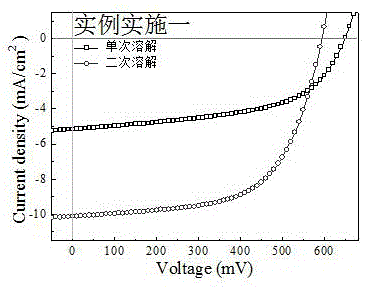Method for improving efficiency of organic polymer photovoltaic cells
A photovoltaic cell, polymer technology, applied in photovoltaic power generation, circuits, electrical components, etc., can solve problems such as low photoelectric conversion efficiency
- Summary
- Abstract
- Description
- Claims
- Application Information
AI Technical Summary
Problems solved by technology
Method used
Image
Examples
Embodiment 1
[0015] According to the above-mentioned content of the invention, the P3HT:PCBM photovoltaic system was selected as the experimental object, and the P3HT:PCBM (mass ratio 1:1, the concentration was both 20 mg / ml) was first dissolved in chloroform solvent, stirred magnetically for 8 h, and then the dissolution bottle was opened, Let the chloroform evaporate naturally. Then use o-dichlorobenzene to dissolve the photoactive film in the bottle, and stir it magnetically for more than 12 h to prepare the precursor solution for the formal photoactive layer film.
[0016] After cleaning the ITO conductive glass substrate, spin-coat ZnO functional layer on its surface, and then apply the prepared solution on the surface of ZnO by spraying method (the dosage is 20 ul, and the spin-coating is carried out in two steps: 600 r / min). , 6 s and 1200 r / min, 20 s). Then, the obtained photoactive layer film was naturally air-dried. After drying, MoO was successively evaporated on the surface o...
Embodiment 2
[0018] According to the above-mentioned content of the invention, select PTB7:PC 71 The BM photovoltaic system was used as the experimental object, and PTB7:PC was first dissolved in chloroform solvent. 71 BM (mass ratio 1:1.5, PTB7 concentration is 10 mg / ml, PC 71 BM concentration is 15 mg / ml), stir magnetically for 8 h, then open the dissolution bottle and let the chloroform evaporate naturally. Dissolve the photoactive film in the bottle with dichloroethane and stir magnetically for more than 8 h. Finally, a mixed solvent of chlorobenzene and 1,8-diiodooctane (97%: 3%) was used to dissolve PTB7:PC 71 BM to prepare the precursor solution for making the formal photoactive layer thin film.
[0019] After cleaning the ITO conductive glass substrate, spin-coat the ZnO functional layer on its surface, and then apply the above-prepared solution to the surface of ZnO by spin-coating method (amount of 20 ul, spin-coating process: 850 r / min, 50 s). Then, the obtained photoactive...
PUM
 Login to View More
Login to View More Abstract
Description
Claims
Application Information
 Login to View More
Login to View More - R&D
- Intellectual Property
- Life Sciences
- Materials
- Tech Scout
- Unparalleled Data Quality
- Higher Quality Content
- 60% Fewer Hallucinations
Browse by: Latest US Patents, China's latest patents, Technical Efficacy Thesaurus, Application Domain, Technology Topic, Popular Technical Reports.
© 2025 PatSnap. All rights reserved.Legal|Privacy policy|Modern Slavery Act Transparency Statement|Sitemap|About US| Contact US: help@patsnap.com



